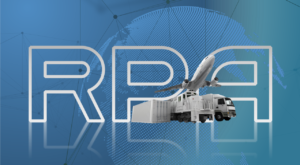According to journalist David Edwards, the business landscape started to digitalize the moment computers were introduced into it over half-a-century ago. Currently, he notes, “One of the most popular and relevant areas of business digitization now is RPA (robotic process automation). The key idea is that the robot performs the same actions as a person, only faster and often better.”[1] In the case of RPA, the term “robotic” can be misleading. The robot in this instance is a rules-based software “bot” that carries out specified instructions in a structured situation. Journalist Angela Scott-Briggs (@AngelaScottBri1) explains, “[RPA utilizes] a manually coded virtual bot that helps automate various business processes that are generally deemed repetitive and a waste of valuable resources such as time and money. The robot part is mostly represented by a virtual character that works based on an algorithm designed to perform tasks in smarter and faster ways than a human ever could. This technology was only affordable by large companies a few years ago however with new business models coming up, companies of all sizes can take advantage of RPA.”[2] She adds, “There still are many misconceptions about what exactly RPA is and its range of capabilities. People sometimes confuse it with artificial intelligence.”
How RPA is Changing the Business Landscape
Devshree Golecha, Head of Business Intelligence & Analytics and Data Council Lead at TDECU, explains that RPA takes over what are sometimes referred to as back-office functions. She writes, “RPA uses automated systems that are governed by business logic and rules to streamline and optimize processes. They are referred to as ‘bots,’ and they help by efficiently and effectively performing repeatable, rules-based tasks. The average knowledge worker employed to perform a back-office operation process has a lot of repetitive, routine tasks that are tedious and uninteresting. The RPA tool mimics the activity of a human being in carrying out a well-defined, rule-based task within a process.”[3] Fortunately, bots don’t get distracted or bored doing tedious work. Tech journalist Joe Green notes, “Deploying computing power on repetitive tasks like data duplication can save time and money, and stop boredom-created errors. … While there are distinct economic benefits associated with RPA deployment, focusing purely on efficiency and cost savings misses the larger picture. By handling more substantial numbers of transactions without errors, customer satisfaction levels are boosted: shorter waiting times and fewer (if any) mistakes.”[4]
Edwards notes, “Robotic process automation has benefited businesses and several industries in multiple ways.”[5] He discusses a few of the benefits. They include:
• Accelerated Digital Transformation: Most business consultants advise their clients that to thrive in the new business landscape they need to transform into digital enterprises. Handling all of the data created by digitalization can be time consuming and tedious. RPA helps deal with data overload. Edwards notes, “With the help of RPAs, transformation gets a speed-up and is called accelerated transformation.”
• Major Cost Saving: Edwards stresses that hiring bots to do repetitive work is “way cheaper than hiring a man to do the same.” Many companies, however, aren’t replacing employees with RPA solutions, they are simply freeing them from tedious tasks. In those cases, cost savings are generally related to improved accuracy and 24/7 operations. As Golecha notes, “By implementing RPA, businesses will be able to reduce the time and money spent performing inefficient operational processes.”
• Greater resilience: Edwards insists, “Resilience means flexibility.” And he believes software bots provide greater flexibility. In the case of RPA, resilience is bolstered by the fact that bots don’t get sick or get tired or make errors due to fatigue.
• High accuracy: Given the right algorithm and access to accurate data, RPA bots will perform flawlessly around the clock. Golecha explains, “Robots can function 24/7/365 [offering] speed and accuracy over human labor. … Irrespective of how tedious, repetitive, or rule-based a process is, bots will follow the rules, ensuring accuracy and reliable results. RPA is especially useful in roles that are prone to human errors.”
• Improved compliance: Compliance to regulations is a big deal for most businesses; especially when it comes to protecting customers’ personal data. Golecha notes, “Bots will not fall for common cyber-related attacks such as spear phishing and social engineering.”
• Boosted productivity: According to Edwards, “68 percent of the working class believe that RPAs will help them become more productive.” Golecha adds, “RPA can lead to significant productivity enhancement. RPA products often come with a drag-and-drop interface, which helps employees because they will not need additional training in coding or other complex fields.”
• Improved employee morale: Golecha notes, “RPA can be an avenue to improved employee efficiency. It lets employees focus on value-adding tasks.” Freed from the drudgery of repetitive tasks, employees can be more engaged in stimulating work that improves their morale.
Brady Brim-DeForest (@bradybd), CEO of TheoremOne and Managing Partner at Halmos Ventures, adds this word of caution: “Before actually implementing [RPA], it’s important to look at the big picture and decide where and when to leverage RPA. What’s the low-hanging fruit? When making the decision, it’s important to remember that RPA isn’t a panacea — it’s one tool in your toolbelt, and to get the best results, you need to apply it judiciously.”[6] As Bill Gates (@BillGates) once noted, “The first rule of any technology used in a business is that automation applied to an efficient operation will magnify the efficiency. The second is that automation applied to an inefficient operation will magnify the inefficiency.”
Beyond RPA
As Scott-Briggs noted at the beginning of this article, “People sometimes confuse RPA with artificial intelligence.” Some pundits call RPA a gateway to artificial intelligence. When cognitive technologies are applied to RPA solutions, it is often called Intelligent Process Automation (IPA). At Enterra Solutions®, we call it Cognitive Process Automation™. Naveen Joshi (@joshinav), Founder and CEO of Allerin, explains, “IPA is similar to RPA, but with additional intelligence capabilities. It refers to applying AI and other associated technologies such as computer vision, machine learning, big data analytics and natural language processing to RPA tools. These technologies enable IPA tools to intelligently understand and analyze data and make decisions on [their] own.”[7]
For routine tasks, RPA is sufficient for most businesses. In situations where some discretion must be used, CPA can be a better choice. Jeff Gallino (@JeffGallino), CTO and Founder at CallMiner, explains, “When combined, the two can be used as business and innovation accelerators that not only improve the employee experience, but the customer experience as well, leading to improved customer loyalty, brand reputation and overall bottom-line results.”[8] Min Sun (@GoMinSun), Appier’s Chief AI Scientist, adds, “Many actions, while repetitive, require insight and consideration by a human with knowledge and experience. And this is where the next generation of RPA tools can leverage AI. Humans are very good at answering the question of ‘What else is important or interesting?’. AI will help RPA tools go further than simply adding more variables to a query. AI will allow RPA to take the next step and answer the question of ‘What else?’. In effect, the application of AI to RPA will allow these tools to expand the scope of what they can do.”[9]
Concluding Thoughts
Brim-DeForest observes, “The implementation of RPA can be tricky.” He also believes that trying to mimic human-to-computer actions is the wrong approach. He explains, “Custom RPA implementation should focus on a computer-to-computer interface (like APIs) instead of human-to-computer interface because it removes a layer of fragility, and can be significantly more robust.” Sun concludes, “When automation is targeted and executed well, the business benefits are quickly realized. The next generation of RPA will go further by not only automating routine tasks but by finding opportunities, through the use of AI, to optimize automation and deliver better outcomes.”
Footnotes
[1] David Edwards, “How robots and RPA will change the business of the future,” Robotics & Automation, 17 May 2022.
[2] Angela Scott-Briggs, “What Is Robotic Process Automation & How Relevant Is It Today?” Tech Bullion, 18 May 2022.
[3] Devshree Golecha, “An Insight to Robotic and Intelligent Process Automation,” Quality Digest, 20 November 2018.
[4] Joe Green, “Robots get all the worst jobs: RPA use today,” T_HQ, 15 November 2018.
[5] David Edwards, “How Robotic Process Automation is Impacting Key Industries,” Robotics & Automation, 3 March 2022.
[6] Brady Brim-DeForest, “Why Robotic Process Automation Should Be On Every CTO’s Radar,” Forbes, 29 April 2022.
[7] Naveen Joshi, “It’s Time to Replace RPA with IPA in Recruitment Procedures,” BBN Times, 26 May 2021.
[8] Jeff Gallino, “Why AI And Robotic Process Automation Are The Perfect Match,” Forbes, 18 September 2020.
[9] Min Sun, “The future of RPA: Tapping into the power of AI and data,” ITProPortal, 11 September 2020.





